Vietnam’s Bitexco Financial Tower Signaling Profits for Thu Thiem Investors
By Keith Hilden and Dylan Waller, Squawkonomics
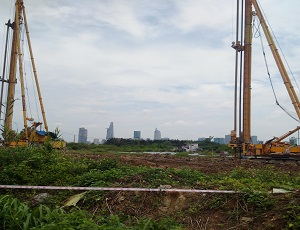
As the Bitexco Financial Tower sits just to the left of the center of the skyline, an assembly of cranes and other construction equipment begin to congregate.
As our crowdfunders and Squawk Hawk newsletter readers already know, within the last 6 months we laid out our Land to Skyscraper Index (LS Index). We have since been tracking multi-billion USD investments into Saigon’s Thu Thiem and a flurry of corporate moves, led by Lotte and other groups of international and domestic consortiums. Referring to our in-house LS Index model, there’s certainly an economic dynamic here to explore– and to participate and profit from. Our previous Squawkonomics research report hosted at Vietnam Briefing lays out that, after Ho Chi Minh City, only Phnom Penh comes close in the world when it comes to such massive land plots next to the respective countries’ prime commercial hub’s tallest skyscrapers.
The jungle foliage at the time of our last visit in Winter 2014 has been replaced by temporary service roads. The remaining drainage of the swampy wetland terrain is set to be a central business district and homestead of Saigon’s future. Evident in our observations not only in the Thu Thiem development area but throughout Vietnam itself is that various projects have struck their first support beams in the soil, and construction cranes have begun to arrive and align.

So many construction vehicles clearing the land so close to the very epicenter of a country’s economy is an absolute rarity in our world today, and a sight to behold that will only be temporary before the landscape is completely transformed.
Developers now look at the country with a willingness to deposit billions of dollars to embark on big ticket projects. Vietnam has made clear steps to embrace market reform and slash bad debt following the country’s 2012 banking meltdown, resulting in a significantly more attractive investment environment today. Projects of this magnitude were practically unheard of in the country not even 10 years ago, and now companies find themselves competing for investment certificates to develop projects all over the country– and in our case, the land of Thu Thiem in Ho Chi Minh City. One needs to see the action on the ground to see the sheer economic audacity of it all–large plots for development in direct eyeshot of a global trade center’s tallest skyscraper located squarely in the CBD, a sight that is seen nowhere else in the world. This video clearly lays out why we believe global capital has no other large scale capital allocation opportunity for premium urban land development in any country’s major commercial hub today, and we highlight investment options for those who want to take direct action in the markets.
The Players Involved
The investment environment of Thu Thiem has been running on completely different dynamics for 2015, and there has been a lot of sudden developments resulting in a rapid transformation of the area.
Firms on the Ground:
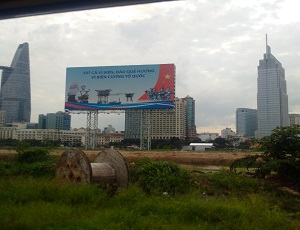
A wooden roll empty of coil sits in grassland, rapidly to be replaced by some of the largest developmental projects and buildings Vietnam has ever seen in its history. The billboard above talks about defending Vietnam’s sea borders.
Sacomreal emerged as one of the early – and only – players in Thu Thiem in 2011 along with real estate company Thanh Thanh Cong and engineering company Vietracimex, and they appeared to be active on the scene when Thu Thiem land prices were at essentially native jungles and wetland price points. Sacomreal is still on the scene, active in a variety of construction projects in Thu Thiem. Fecon has emerged as a key player for land preparation and underground construction, setting up a temporary office along the waterfront directly overlooking the Bitexco Financial Tower, and are currently negotiating to gain additional construction contracts, showing a landscape that established companies are looking to be a part of.
Beton 6 is working on connecting the affluent Phu My Hung district of Saigon with Thu Thiem through bridge construction projects, and Vietnamese bank Eximbank is already prominently displaying their presence and cooperation with Sacomreal and TFC in some real estate projects along Mai Chi Tho.
Hoa Binh Construction has been moving forward with some sizable developments along the Mai Chi Tho strip, as well as right next to the Dai Quang Minh development, with a line of luxury villas currently under construction. Cotec Construction has also included Thu Thiem as a site for its operations.
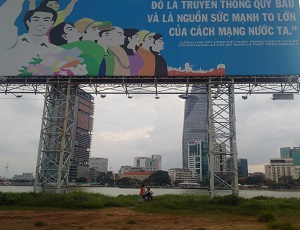
Temporary propaganda billboards dot the pre-development landscape as two young boys enjoy the riverview before the largest skyscraper in Ho Chi Minh City.
CII is literally all over, and is the unofficial 800 pound gorilla in the room by sheer projects that they are taking on. CII is trailblazing forward, marking itself as one of the most influential investors in the Thu Thiem area, and most recently received a 2 trillion VND loan from BIDV in recent weeks. CII’s recent investment trade show to the United States, wooing such investors as leading Asian emerging and frontier investment firm Decker and Co., marks a critical shift in mindset for Vietnamese companies, by way of looking abroad to secure capital for Vietnam domestic investment projects. Anphong Construction is also a dominant player, as the construction company of choice for Dai Quang Minh and other projects peppered across the wetland development landscape. Thuanviet is a construction company also active in the area, cooperating with Sacomreal in various real estate projects built along Mai Chi Tho in the Khu Do Thi Sala area.
Vietnamese flagship firm Vingroup has also chosen to invest in such Thu Thiem development projects as the large Khu Do Thi Sala that will develop almost all of the available land on Thu Thiem south of Mai Chi Tho. Foreign investors tend to herd around Vingroup as a public equity choice. If Vingroup is now involved in the Thu Thiem area, expect the activities in Thu Thiem to become a mainstream investment topic soon for foreign investors into Vietnam.
Foreign Capital on the Ground
Foreign investors have initiated big ticket projects, led by the trifecta of Lotte, Mitsubishi, and Toshiba’s US$1 billion joint investment into the upcoming Eco Smart City project, while Gaw Capital, Tien Phuoc Real Estate and Tran Thai Lands are pushing forward on a joint investment to build the Thu Thiem Observatory Tower, which at its completion will be Vietnam’s tallest skyscraper. The joint venture investment will also include a five-star hotel, a shopping mall, and an office complex. These two investments all told will exceed over US$4 billion, and this investment amount does not include the large domestic funded Khu Do Thi Sala construction project south of Mai Chi Tho.
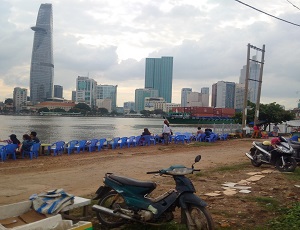
The dirt road and the patches of mud and grass behind the motorcycle offer a real feeling as to how empty the land is on the other side of the river. Locals use this riverside for the meantime to drink ca phe sua da, the country’s trademark way to drink coffee with condensed milk, along with tra da, a jasmine tea, alongside conversation with friends.
Foreign SMEs and mid-size corporations have been moving in on the land to nail lucrative contracts such as WSP Finland, the company that designed the to-be-constructed Thu Thiem No. 2 Bridge. Korea’s Kunwha Engineering is a small firm with a big footprint in engineering projects all across Vietnam, and they have made sure to involve themselves in Thu Thiem development as well. Vietnamese cement maker Lephan has recently opened a new cement production facility in Thu Thiem in order to be in immediate proximity to the demand for construction materials, and along with Fecon’s recent move to set up a physical presence along the Thu Thiem riverfront, there is a market indicator that Vietnamese firms expect more business from the Thu Thiem development and are positioning themselves accordingly.
For international developers wanting to develop a large project next to a commercial center and a country’s megacity’s dominant skyline tower, there are such few options in the world, implying that by supply and demand dynamics alone, global development capital will inevitably invest into these areas and make these economic outliers relics of the past. Knowing the key players in these developments that we have laid out will do wonders for your portfolio construction, as you can get a piece of the action in literally building a developing megacity’s new central business district.
|
Squawkonomics is a crowdfunded frontier market investment research firm that handles investment into over 10 industrial areas in Cambodia and Vietnam, and provides a wide array of investment research reports concerning the Asia Pacific and Latin American investment opportunities. Squawkonomics also assists investors with our portfolio of private equity investments, laying out promising opportunities throughout the APAC and LATAM regions. For investors in need of finding their next investment destination in Southeast Asia, contact us for details. Asia Briefing Ltd. is a subsidiary of Dezan Shira & Associates. Dezan Shira is a specialist foreign direct investment practice, providing corporate establishment, business advisory, tax advisory and compliance, accounting, payroll, due diligence and financial review services to multinationals investing in China, Hong Kong, India, Vietnam, Singapore and the rest of ASEAN. For further information, please email asean@dezshira.com or visit www.dezshira.com. Stay up to date with the latest business and investment trends in Asia by subscribing to our complimentary update service featuring news, commentary and regulatory insight. |
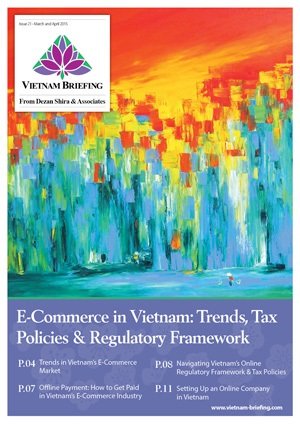 E-Commerce in Vietnam: Trends, Tax Policies & Regulatory Framework
E-Commerce in Vietnam: Trends, Tax Policies & Regulatory Framework
In this issue of Vietnam Briefing Magazine, we provide readers with a complete understanding of Vietnam’s e-commerce industry. We begin by highlighting existing trends in the market, paying special attention to scope for foreign investment. We look at means for online sellers to receive payment in Vietnam, examine the industry’s tax and regulatory framework, and discuss how a foreign retailer can actually establish an online company in Vietnam.
The 2015 Asia Tax Comparator
In this issue, we compare and contrast the most relevant tax laws applicable for businesses with a presence in Asia. We analyze the different tax rates of 13 jurisdictions in the region, including India, China, Hong Kong, and the 10 member states of ASEAN. We also take a look at some of the most important compliance issues that businesses should be aware of, and conclude by discussing some of the most important tax and finance concerns companies will face when entering Asia.
 The Asia Sourcing Guide 2015
The Asia Sourcing Guide 2015
In this issue of Asia Briefing, we explain how and why the Asian sourcing market is changing, compare wage overheads, and look at where certain types of products are being manufactured and exported. We discuss the impact of ASEAN’s Free Trade Agreements with China and India, and highlight the options available for establishing a sourcing and quality control model in three locations: Vietnam, China, and India. Finally, we examine the differences in quality control in each of these markets.
- Previous Article Vietnam Mulls Law Requiring Shipping Companies to Publicize their Freight Tariffs
- Next Article The TPP and Vietnam: A Market Entry FDI Signal for Firms Along the Efficiency Chain









